Ajith N Nair, Harshwardhan Tanwar, Pandarasamy Arjunan, Prashant Anand, and Ardeshir Mahdavi.
Abstract.
Occupant presence and their behaviour in the built environment significantly impact energy consumption in buildings. Currently, building systems are often operated based on assumed occupancy and fixed schedules, or occupants manually adjust them for their comfort, which sometimes leads to energy wastage. Also, the inherent complexity and unpredictability of occupancy patterns can contribute to disparities between simulated and actual energy consumption, underscoring the importance of selecting suitable methods for occupancy prediction.
Various methods, such as occupancy cameras, thermal imagers, Passive Infrared Sensors, and Radio-Frequency Identification, can collect occupancy information. However, they often come with limitations including cost, complexity, and invasiveness. Hence, there is a growing interest in creating occupancy prediction models using an indirect approach based on indoor air quality (IAQ) data.
However, this indirect approach must be further explored within the building simulation field. In this study, we apply an approach based on the novel QLattice algorithm for occupancy detection, utilizing a minimal sensing strategy with a comprehensive set of IAQ data. Furthermore, we compare the QLattice algorithm’s performance with that of traditional machine learning (ML) algorithms such as Support Vector Machines (SVM), Decision Trees (DT), and XGBoost using metrics including accuracy, precision, recall, F1 score, AUC-ROC values, and computational time.
The QLattice algorithm outperforms traditional ML algorithms in all evaluation metrics, achieving over 90% accuracy on the test dataset. Additionally, compared to traditional black-box ML algorithms, the QLattice stands out for its explainability and interpretability, providing insights useful in decision-making.












